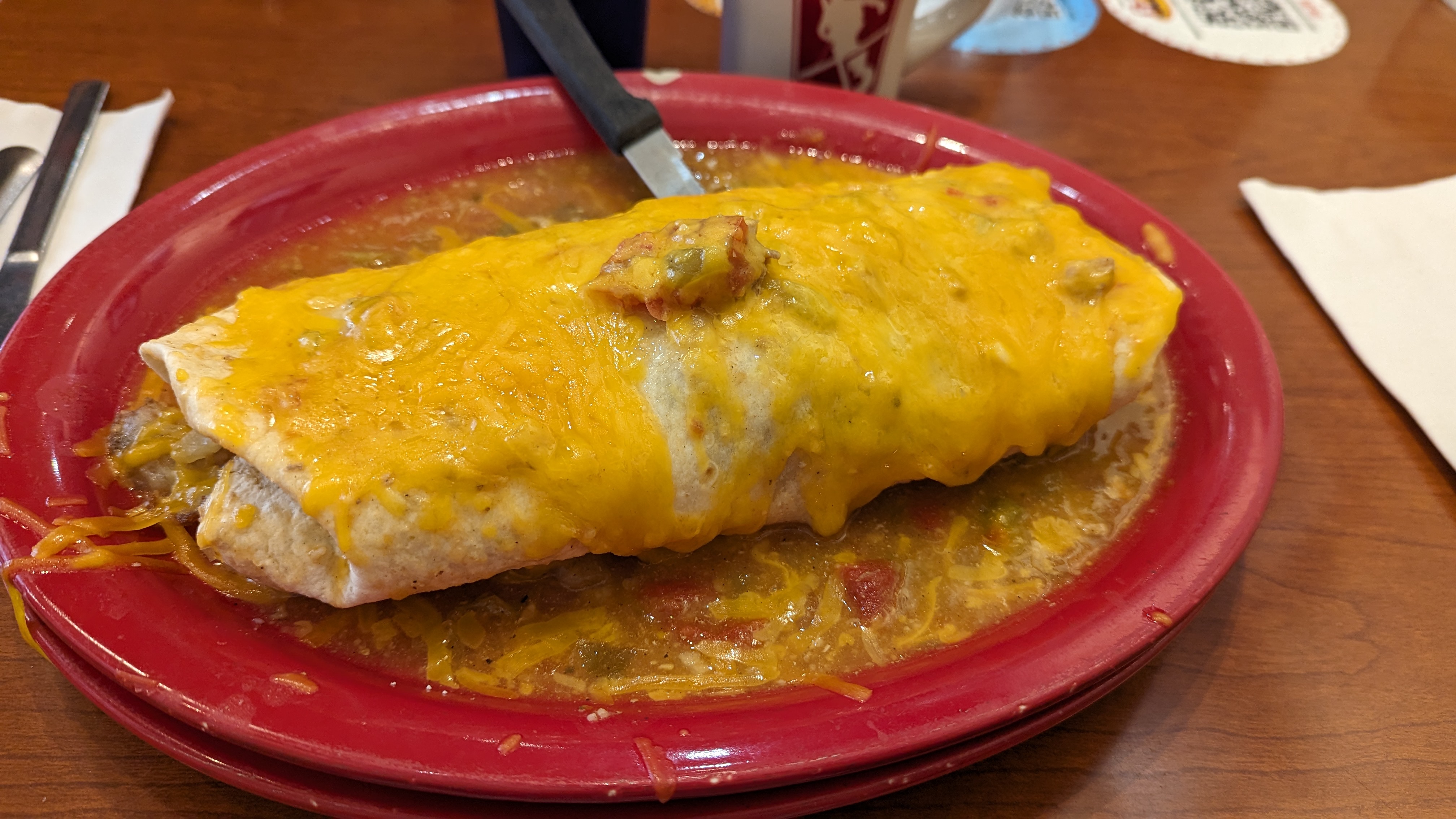
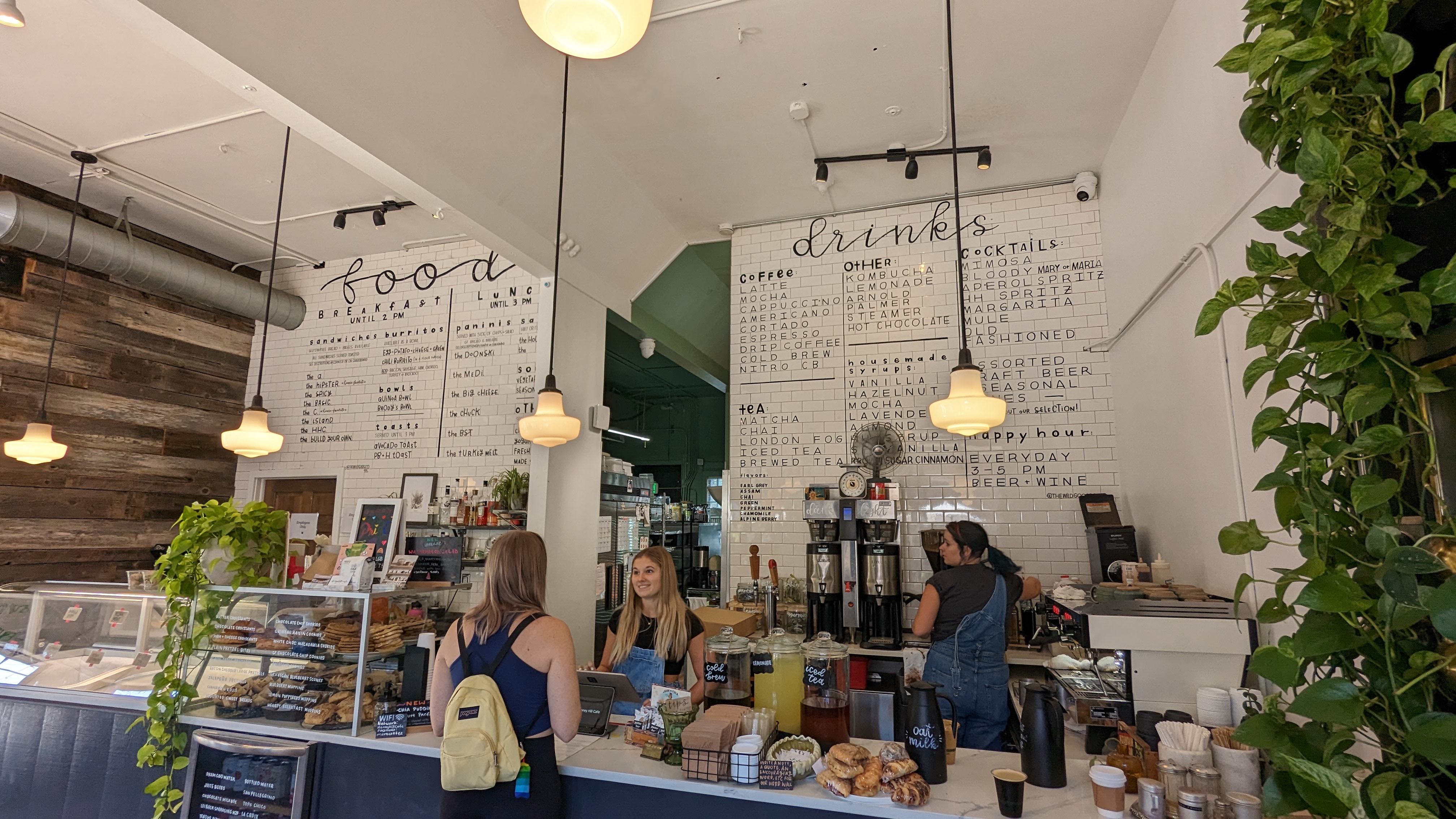
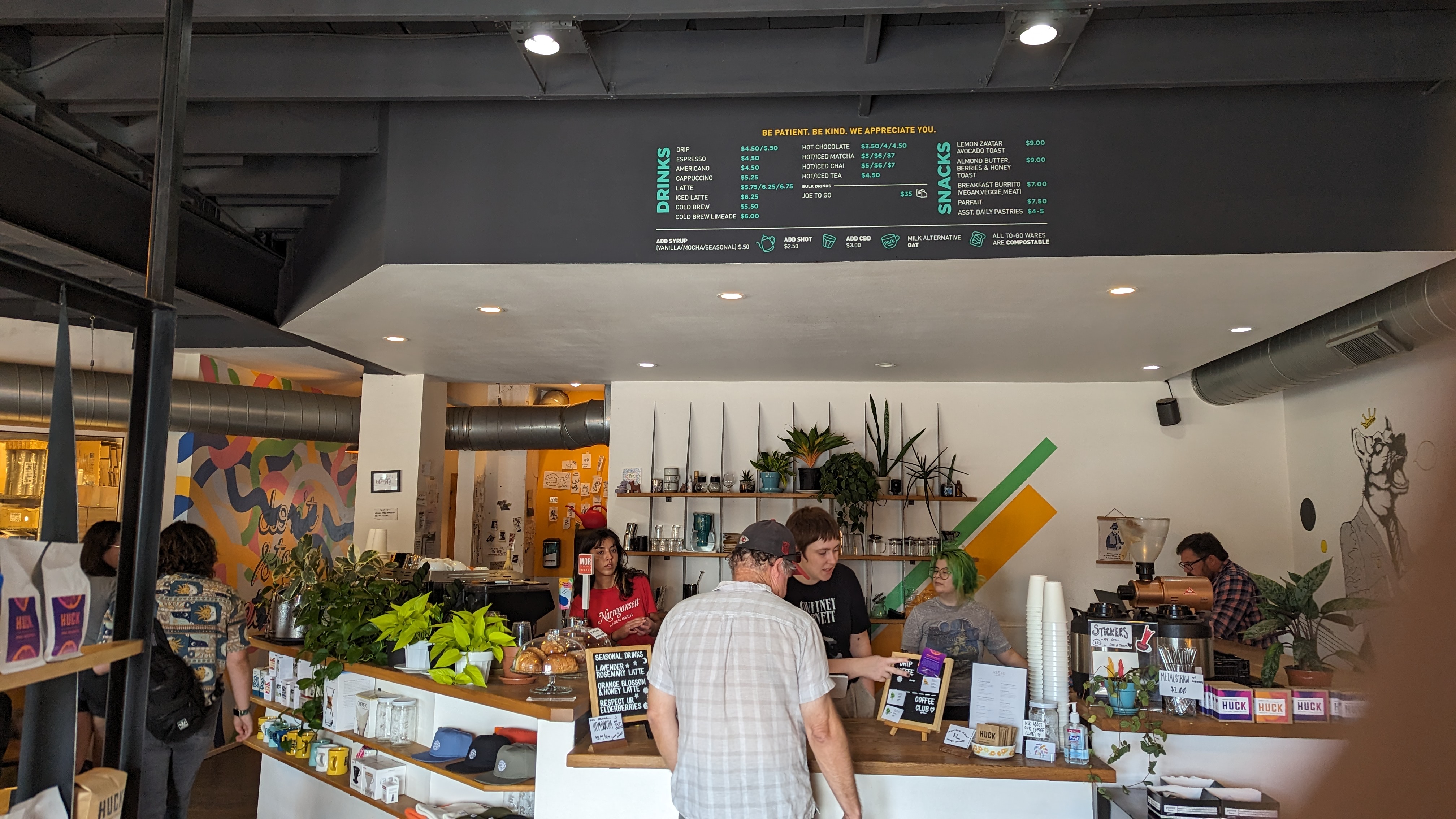
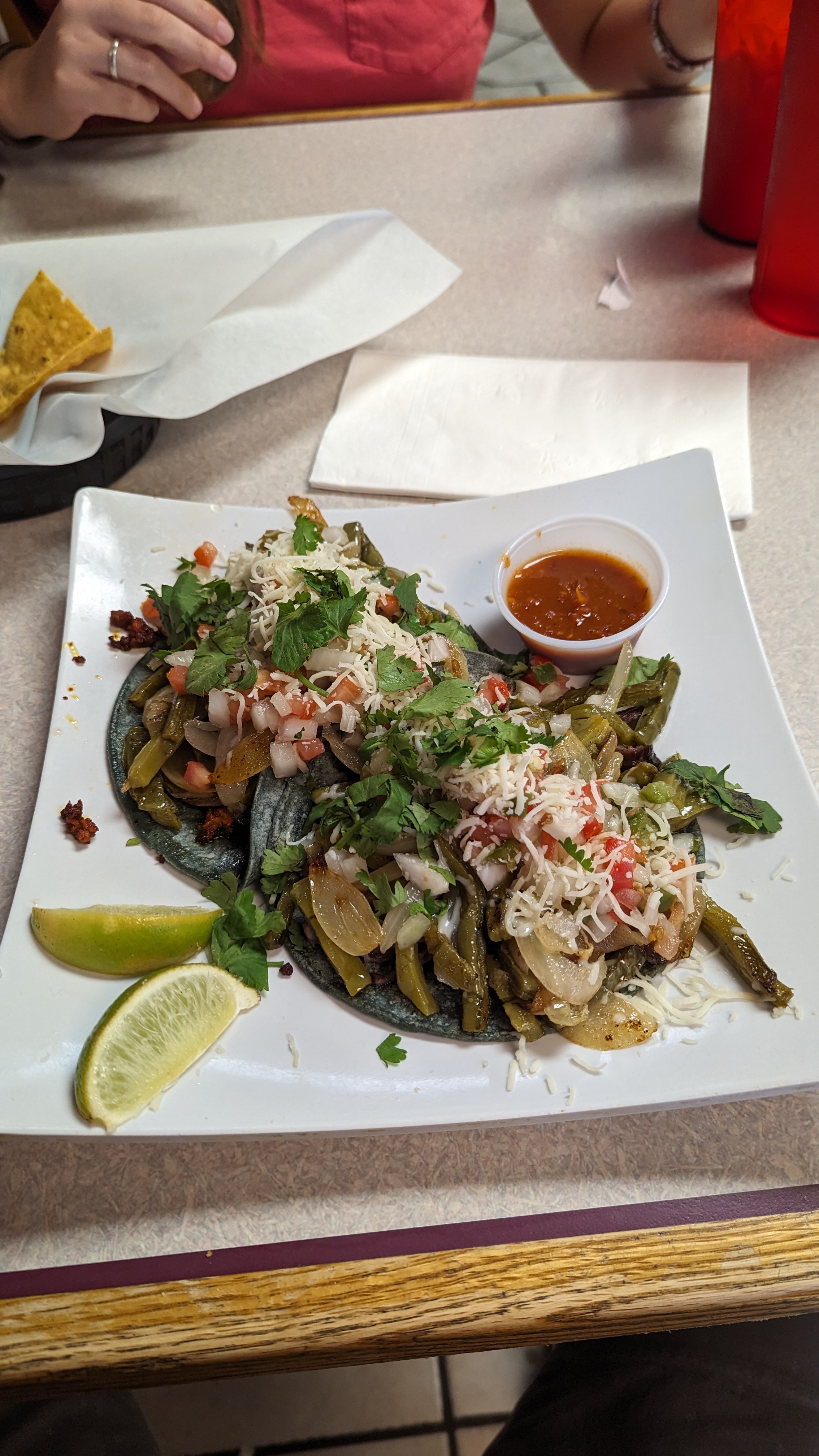
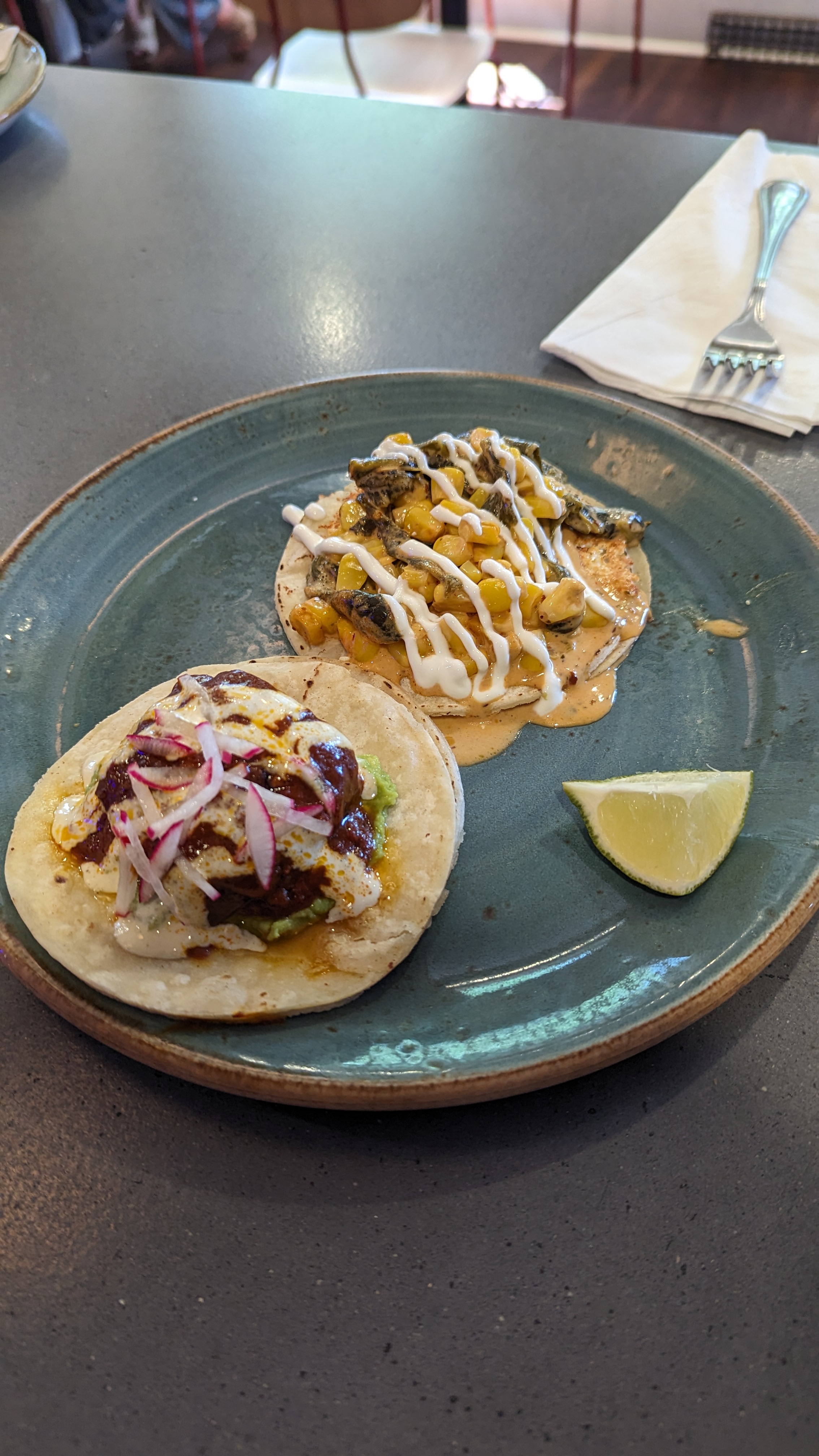
I recently visited Denver for the first time and thought I'd write up some of the highlights of the food. My friend Molly was gracious enough to host and show me around the Mile High City. The first night, we and another friend visited a speakeasy called Retrograde, ensconced behind a freezer door in an ice-cream shop. There I had my first and perhaps most baffling brush with the law, wherein the bouncer glanced at my driver's license and immediately told me that they couldn't accept identification of vertical orientation. Even more strangely was the fact that he did allow me to use a picture of my passport on my phone, which begs the question of the relative ease of falsifying passport photos over geometric variations of driver's licenses.
Idenfication snafu notwithstanding, we were ushered over the threshold after a fifteen minute wait and into a dimly lit
room with striking lighting and a projector on the wall. Just as striking were the fancifully named drinks ("The Amazing Bulk", "Vicious Lips")
which combined several unrecognizable ingredients, such as "chareau" (aloe liqueur), "switched comoz blanc" (vermouth) with
the baffling (acidified carrot). Nonetheless, they excelled in delivering alcohol and pleasure, ultimately the point of drinking at all.
The next day began at the diner Sam's No. 3 (of which there are three locations, as expected, but all with the same number,
unexpectedly). As all good diners, Sam's No. 3 boasts an expansive menu constructed from every possible combination
of ten ingredients (programmatically generating a 1024 item-menu by combinatorics alone). I elected to try the "Rockies Burrito",
consisting of a flour tortilla filled with not just the usual breakfast burrito suspects of potatoes, eggs, and cheese, but
also
That night, we prepared a simple dinner of panzanella and roasted vegetables. There's not too much to say here,
but I'll note again that panzanella is another beautiful illustration of the "soggy fried" concept, though
more precisely the bread is just baked to dehydrate it rather than fried. The key to a good panzanella is good tomatoes,
just like many great pleasures in life (BLTs, tomato sandwiches, caprese salad
A useful maxim is to never make a caprese salad with off season
tomatoes! Lest you be forever disappointed in your life choices.
).
In an ideal panzanella, dehydrated bread is reanimated by the rich liquid extracted from ripe tomatoes, imbuing
every bite with both concentrated tomato flavor and residual crunch from the bread. The tomatoes themselves add
further textural contrast.
As I've been alluding to already, one of Denver's great pleasures is green chile, more in the
New Mexican style, though perhaps
less well-known. Like New Mexico's famed green chiles (I'm referring here to the vegetable rather than the stew
Yes, I know that botanically chiles are
fruits. The US Supreme Court would agree with me when it comes to common usage, though.
),
Colorado's local chiles (apparently called Pueblo chiles)
are a mainstay in the local chile stew. My wonderful hosts, Molly's parents, graciously offered to give a taste
of their world-famous green chile. I'll have to check on the specifics of the recipe once I get them from Molly's dad,
but the main components seem to be (besides the eponymous ingredient) simply tomatoes and garlic for flavor. One can add pork,
but it's not at all necessary. Interestingly, compared with pozole verde—what I assume must be green chile's ancestor—it uses
plain red tomatoes rather than the green tomatillo (same nightshade family, but different genuses). However, the rich, complex
flavors of the green chiles are plenty to provide a great depth to the stew and the tomatoes provide an unexpectedly pleasant acidity. Although you can certainly
see the family resemblance to pozole, the details have on been changed. But they make for a distinctive eating experience, due to the lower
acidity of the red tomatoes with regard to tomatillos and the different flavors of typical green chiles.
Served with some hominy, fresh cilantro, avocado, and lime, I have to admit that green chile absolutely
The next day, upon recommendation of Molly parents, I sought out the breakfast burrito at a local café Honey Hill. By now, you should be able to guess that it includes green chile (along with the requisite potatoes and eggs). Lots of breakfast burritos in Denver! Unlike the first one, however, this burrito was manageably sized and texturally homogenous for the most part. Although I've extolled the virtues of texture contrasts, textural homogeneity, especially when it comes to soft foods, can be just as luxurious (think tortilla española). In this case, the eggs and potatoes provided subtle shades of tenderness, with just the right amount of toothsomeness coming from the tortilla. The green chile lent its welcome acidic undertone, much like a good hot sauce does. Overall, a burrito that met its high expectations.
For lunch, we returned to in fact the same corner, just across the street, where the reputed Spinelli's grocery serves a lineup of classic sandwiches. Although their typical sandwiches tend to encompass the more traditional deli makeup of cold cuts and cheeses, I decided on a special of the day with cochinita pibil, slaw, and habanero sauce. The sandwich was served on some kind of roll with a soft, slightly chewy texture that absorbed the juices from the pork admirably. The slaw provided a welcome tangy note and crunchy contrast, but I found the habanero sauce to be rather lacking in fire, given that it was supposed to be made with habaneros. Yucatec food, to my knowledge, is especially spicy given their liberal application of habanero chiles, so I was expecting more of a punch; although, certainly Spinelli's is not known for their Mexican cuisine.
On my final day, we decided one would be remiss in a food tour of Denver without sampling the tacos.
The ever-reliable food publication
Shameless plug: the map has recommended coffee shops, roasteries
etc. throughout the US and abroad.
that some friends and I maintain. The shop we visited is located on the western side of Denver in a neighborhood called Sunnyside.
On a side note unrelated to coffee, we passed several so called slot homes
in the area, which have apparently generated quite a bit of hullabaloo
Who knew that it was spelled thus? I certainly did not.
(see the linked article) regarding their rather
blatant disregard for neighborhood atmosphere (and aesthetics, in my opinion). Having all the doors to peoples homes facing inwards
seems like an awful way to stimulate the natural interaction that characterizes a healthy community, so I was pleased to hear
that the city was trying to place a moratorium on construction of new slot homes.
Digression on urban planning aside, the coffee at Huckleberry was incredible, and the barista super helpful
in picking out some bags of coffee beans to bring home. These days, when I visit a new coffee shop, I more often
than not order a plain drip coffee as a useful barometer the shop as a whole
(one might also try their plain espresso, but I don't enjoy that as much). The reasoning goes that making really good drip
coffee requires diligence—good beans and equipment, obviously, but, most importantly, care in making sure the drip coffee
remains relatively fresh (not letting it turn stale) and as good as the lattes. Moreover, drip coffee is
After coffee, we took a not-short detour to visit the Red Rock Amphiteatre, a notable local attraction featuring a naturally occurring rock amphitheatre
purposed for musical events. As a brief note, I find it incredbly fascinating how the geological topology produces such a remarkable acoustic in the outdoor
venue, and that such a formation just exists in the mountains for us humans to avail ourselves with. The walk up and around the amphitheatre helpfully
built up an appetite before our first taco stop at Garibaldi Mexican Bistro (in the southern part of Denver near Englewood). Most charming about Garibaldi
Mexican Bistro is that it's located
Here are more
links (courtesy of Molly) in Spanish with information
on the history and production of cecina.
The first bite of the taco exploded with flavors of each of the components: smoke and umami from the cecina, acidity from the nopal, freshness from
the vegetables, saltiness from the cheese, piquancy from the salsa, and a bass-like earthiness from the blue corn tortilla.
The experience felt kaleidoscopic and yet each part felt integral to the whole, as any good taco should be.
To be honest, I am not generally a fan of nopales due to their sour taste and rather mucilaginous texture, but here
they provided a wonderful bright contrast to the richness of the meat. Altogether, a 10/10 taco-eating experience for me.
Our second and unfortunately final stop, because the Aztec tacos were so filling, was at Tacos Tequila Whiskey, with a completely
different ambiance—clearly catering to the yuppie crowd with "an elevated take on street tacos" (Google's words, not mine).
We ordered one pork belly taco with a crema-based sauce and a grilled mushroom taco with chipotle corn (I also tried their paloma, which
was delicious). The pork belly was succulent and deeply spiced, almost reminiscent of five-spice pork, while the grilled mushrooms taco was
rich and layered with the corn and creamy sauce. Were they both delicious? Absolutely. Would I eat them again? Absolutely. Would I still
rather have a banging al pastor taco from a food truck at half the price? Absolutely. Alas, such is the existence of an
upscale taco restaurant.
So with that, it was time to leave Denver for the time being, but not without a hearty and satisfying introduction to the city's myriad food options. Thanks again to Molly for being such a wonderful host and Denver expert, and I certainly hope to be back soon to continue these delicious adventures.